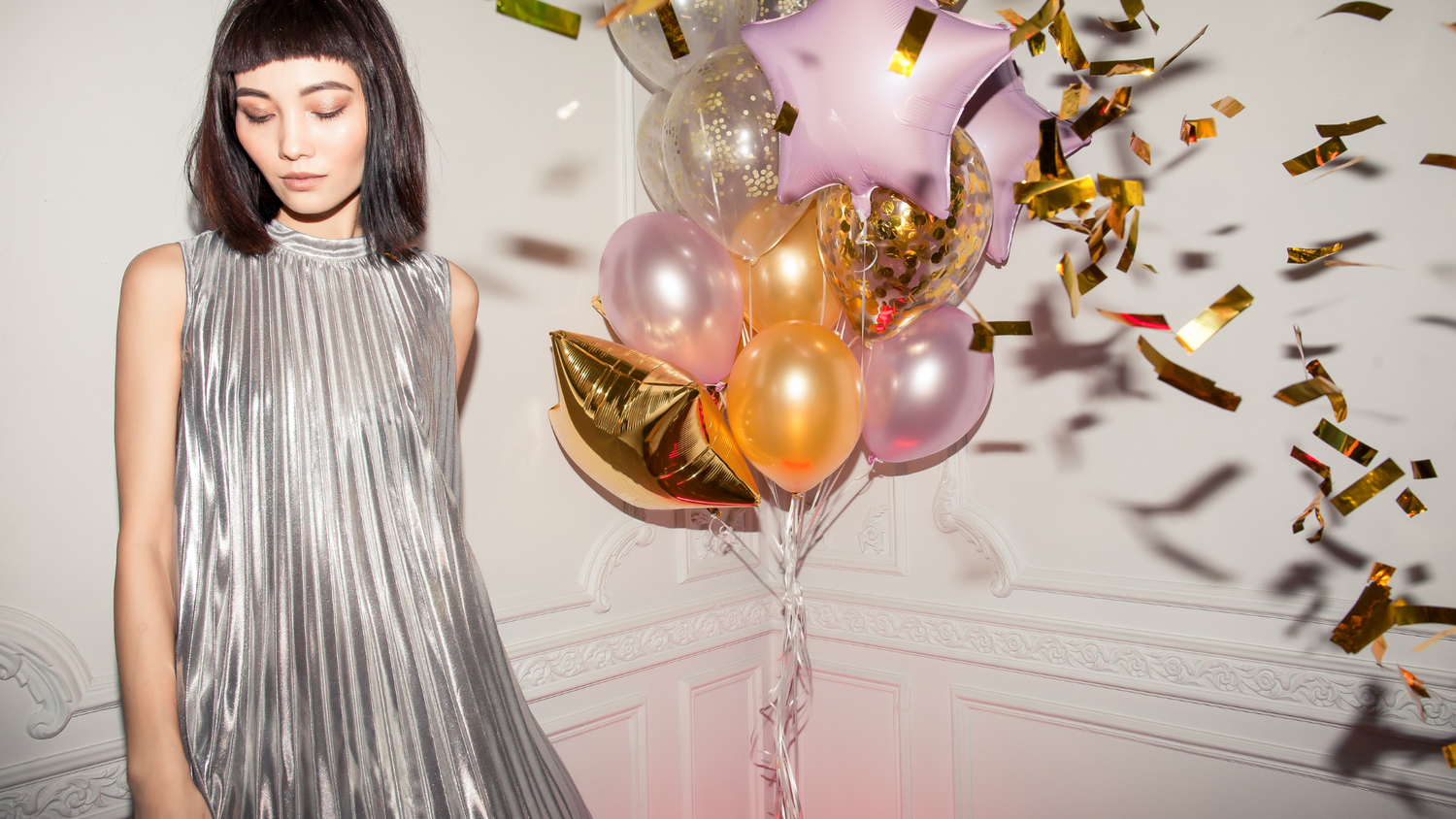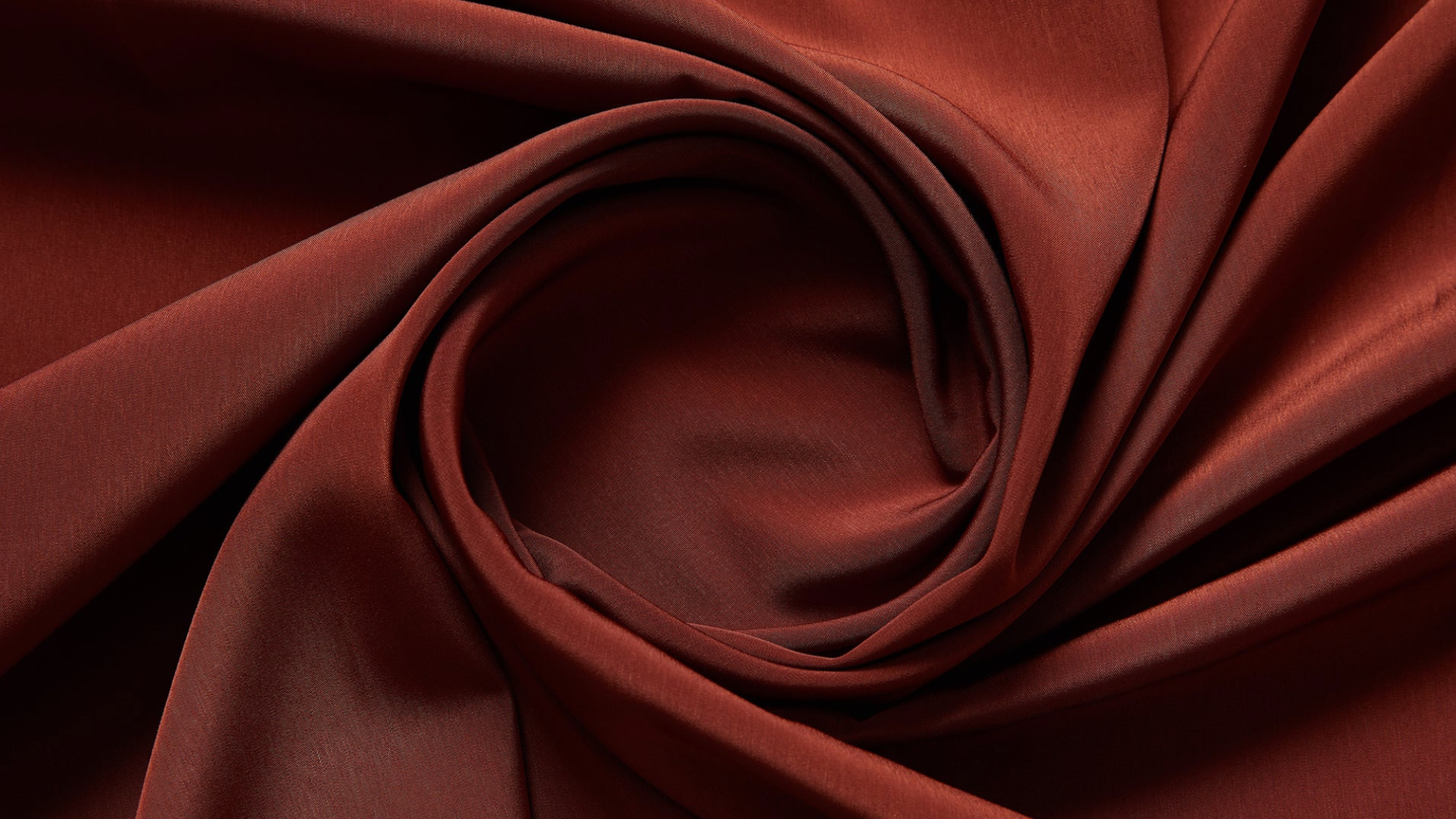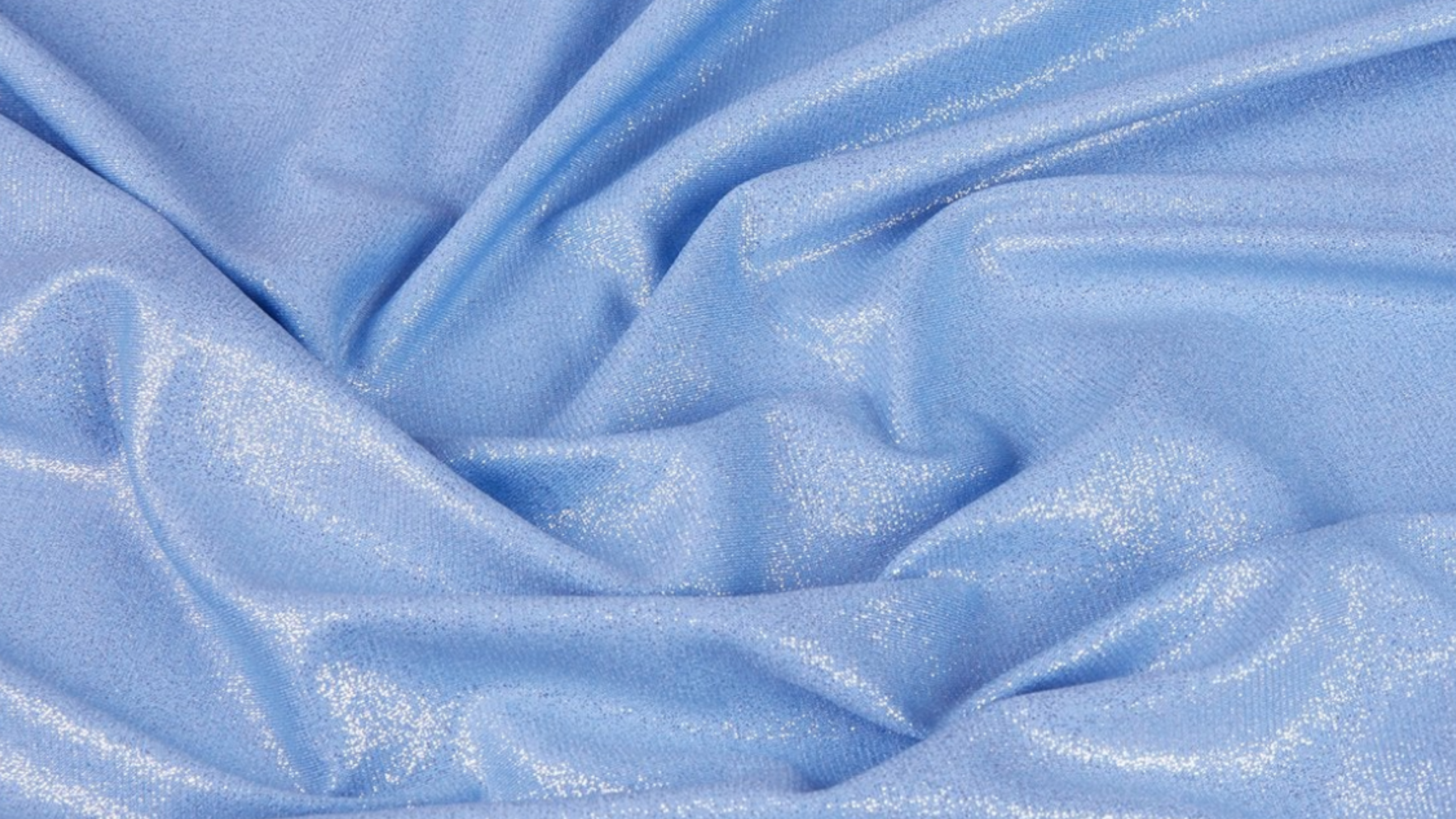One thing about pleats? They never miss!
Pleated fabrics add instant dimension and movement to any design. The magic of pleats lies in their ability to create visual interest while maintaining functionality. They can make a simple silhouette look complex, add fullness without bulk, and create movement that responds to every step you take. Plus, you can use them to create almost anything for different functions, including everyday cotton skirts, luxurious silk evening gowns, and dramatic home decor pieces.
What is Pleat Fabric?
Pleated fabric is any textile that has been permanently folded, pressed, or manipulated to create raised ridges and recessed valleys. These folds are engineered into the fabric's structure, giving it dimensional qualities that change how light hits the surface and how the material moves. They can be made from various materials, including cotton, silk, chiffon, polyester, and more.

Croatia Multi Lurex Pleated Knit
The key to good pleated fabric is that the folds stay put. This is achieved through heat setting (for synthetic fibers), chemical treatments, or mechanical pressing that "trains" the fabric to hold its shape. The result is a textile that maintains its sculptural quality through wear, washing, and handling.
Also, the pleats can vary in size, depth, and spacing, creating different textures and visual effects in the fabric. Pleated fabrics are commonly used in fashion and interior design to add texture, dimension, and a distinctive aesthetic to clothing, drapery, upholstery, and other items. They can be found in various styles and are often chosen for their elegant and decorative qualities.
Types of Pleats and Their Uses
1. Accordion Pleats
Accordion Pleats are the drama queens of the pleating world. These uniform, parallel folds create maximum movement and flow: think of a fan opening and closing. They're perfect for circle skirts, flowing pants, and curtains where you want serious volume and sway. The folds are narrow and evenly spaced, and create that classic "accordion" appearance that expands and contracts as you move.
2. Knife Pleats and Plissé
Knife Pleats and Plissé deliver sharp, crisp lines with a more tailored feel. Knife pleats all fold in the same direction, creating clean, geometric lines that work beautifully in structured garments like school uniform skirts or sharp blazers. Plissé refers to fabric that's been chemically or mechanically pleated into tiny, tight folds. It's lighter than accordion pleating but still adds texture and visual interest.

3. Micro Pleated and Soft Pleated fabrics
Micro Pleated and Soft Pleated fabrics offer subtle texture without overwhelming volume. These smaller, more delicate folds work well when you want the benefits of pleating, think texture, movement, surface interest, without the full drama. They're ideal for blouses, lightweight dresses, and anywhere you want sophisticated detail that doesn't compete with the overall silhouette.
4. Custom Pleats
Custom Pleats open up endless possibilities for designers as it lets you create the exact effect you’re after, whether it's asymmetrical folds or gradient sizing. Many high-end fashion houses use custom pleating to create signature textures that become part of their brand identity.
Other types are:
-
Box Pleats: These are pleats that fold in a way that the fabric forms a box-like structure when viewed from the side.
-
Sunburst Pleats: These are pleats that radiate out from a central point, resembling the rays of the sun.
-
Inverted Pleats: These are pleats that fold inwards, creating a smooth appearance on the outside while concealing the folded fabric inside.
The specific name for pleated fabric may depend on the type of pleating technique used and the intended design of the fabric.

Zelouf Alora Printed Pleated Lurex Mesh in Aqua/Coral
How do I sew pleated fabric?
Sewing pleated fabric can be a bit more challenging than sewing flat fabric, but with some care and attention, you can achieve beautiful results. Here are some tips for sewing pleated fabric:
Step 1: Select the Right Needle and Thread:
Use a needle appropriate for your fabric type. For most lightweight to medium fabrics, a universal needle will work. For heavier fabrics, consider a denim or heavy-duty needle. Also, choose a thread that matches your fabric and is suitable for your sewing machine.
Step 2: Press Your Pleats
Before sewing, press your pleats using an iron. This helps set the pleats and makes sewing more accurate.
Step 3: Use Pins or Clips
Secure your pleats in place with pins or fabric clips to prevent them from shifting while sewing.
Step 4: Start with a Test Piece
If you're new to sewing pleats, practice on a scrap piece of fabric first to get the hang of it.
Step 5: Sew Slowly and Carefully
Sew at a slower pace than usual, especially when sewing over pleats, to maintain accuracy and control.
Step 6: Backstitch at the Start and End
Always backstitch at the beginning and end of your pleated seam to secure the stitches in place.
Step 7: Consider the Direction of Pleats
Be mindful of the direction in which your pleats fold. Sew with the pleat direction to avoid puckering or bunching.
Step 8: Trim Excess Seam Allowance:
Trim any excess seam allowance to reduce bulk inside the pleats. This helps the pleats lie flat.
Step 9: Grade Seam Allowances
If your pleated fabric is thick, consider grading the seam allowances to reduce bulk further.
Step 10: Press Again After Sewing
After sewing your pleated seam, press it again to set the stitches and ensure a crisp finish.
Step 11: Practice Precision
Accuracy is key when sewing pleats, so take your time to ensure the pleats are evenly spaced and aligned.
Other essential tips are:
-
Match the thread color to your fabric, and adjust the thread tension as needed to prevent puckering or loose stitches.
-
Use a Walking Foot or Even Feed Foot. These presser feet can help feed the fabric evenly through the machine, which is especially useful when sewing pleated fabric.
-
Take Breaks and Stay Patient. Sewing pleats can be meticulous work, so take breaks when needed to maintain focus and patience.
Remember that practice makes perfect, and with time, you'll become more proficient at sewing pleated fabric by the yard.

Zelouf Melanie Dot Foil Pleated Bodre in Dazzling Rose
How to Wear Pleated Fabrics
1. Pair it with your Everyday Fashion
Pleated fabrics work harder in your wardrobe than you might expect. A pleated cotton skirt paired with a simple tee creates instant polish for casual days. Pleated blouses add texture and interest to basic pants or skirts. The key is balance. Let the pleating be the star by keeping other elements simple.
When styling pleated pieces, consider proportion. Larger, more dramatic pleats work well when they're the main event—think statement skirts or flowing pants. Smaller, more subtle pleating can be layered and combined with other textures without overwhelming the look.
2. Designer & Custom Looks
High-end fashion regularly showcases pleating as both a technique and an art form. Designers use pleating to create everything from architectural silhouettes to fluid, sculptural pieces that blur the line between clothing and art.
Custom pleated fabrics let you create exactly the effect you want. You might combine different pleating techniques in one piece, use pleating to create asymmetrical effects, or mix pleated fabrics with flat materials for contrast. The possibilities are endless when you're not limited to ready-made options.
3. Home Decor with Pleats
Pleated fabrics aren't just for clothing. Pleated curtains add texture and depth to windows while providing excellent light control—the folds create natural filtering effects. Pleated cushions and throws introduce tactile interest to furniture and rooms.
In home decor, pleating can make spaces feel more dynamic and luxurious. A pleated table runner creates visual movement across a dining table. Pleated lamp shades cast interesting shadow patterns. The three-dimensional quality of pleated fabrics adds sophistication to any interior.
How do I care for pleated fabric?
Caring for pleated fabric requires gentle handling to maintain the structural integrity of those carefully formed folds. Here's how to keep your pleated pieces looking sharp:
- Read the Care Label First. Different fabrics and pleating techniques have specific requirements. Some pleated fabrics are machine washable, others require hand washing or dry cleaning.
- Use the washing method if the care label allows. To do this, use cold or lukewarm water with a gentle detergent designed for delicate fabrics. Gently move the fabric through the water without rubbing or wringing the pleats. Then, rinse thoroughly with cool water until all detergent is gone.
- If the label allows machine washing, use a gentle cycle with cold water. Place pleated items in a mesh laundry bag to protect them from agitation and friction with other garments.
- Avoid aggressive handling. Never wring, twist, or scrub pleated fabrics. These actions can permanently damage the fold structure and leave you with fabric that won't hold its shape.
- To dry the fabric, lay pleated items flat on clean, dry towels and gently reshape the pleats to their original form. Then, air dry in a well-ventilated area away from direct heat or sunlight. Hanging wet pleated items can stretch the pleats out of shape.
- Use a handheld steamer to remove wrinkles. Keep the steamer at a slight distance to avoid flattening pleats. If you must iron, use low heat with a pressing cloth and work on the wrong side of the fabric.
- Store the pleated items separately from other clothing to prevent friction damage. Avoid rough or abrasive surfaces that can snag delicate pleats. For valuable pieces, consider garment bags for extra protection.
- When in doubt, especially for expensive or delicate pieces, use professional dry cleaning. Make sure to point out the pleated details to your cleaner so they can handle the item appropriately.
- For minor stains, use mild detergent and a soft cloth to blot the area gently. Never scrub stains on pleated fabric, as this can disrupt the fold pattern.
- Inspect the fabric regularly to catch problems early. Check for loose threads or damaged pleats and address them promptly to prevent further damage.
Where can I buy pleated fabric?
For the best selection of pleated fabrics in various weights, textures, and colors, check out Zelouff Fabrics. As a third-generation fabric wholesaler, we offer an extensive collection of pleated fabrics by the yard suitable for both fashion and home decor projects.
Conclusion
Pleated fabrics offer endless creative possibilities, whether you're designing the next must-have dress or adding dimensional interest to your living space. With proper care and handling, these sculptural textiles will maintain their beauty and structure for years to come. The key is understanding how pleating works with different fibers and choosing the right type of pleating for your specific project needs.
At Zelouf Fabrics, we have over 90 types of pleated fabric by the yard on our online shop, available wholesale or by the yard. Explore the collection today!




